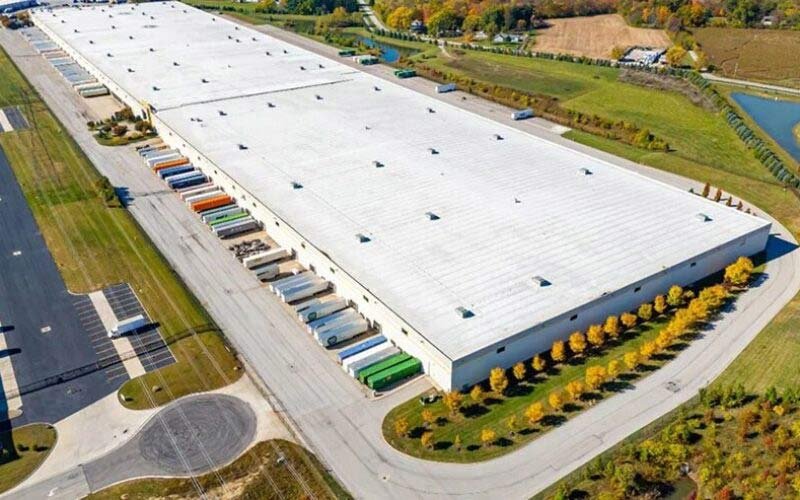The logistics company has launched a new omnichannel facility in Ohio to manage Levi’s wholesale, retail, and e-commerce distribution.

- To enhance its distribution and logistics network, Levi Strauss & Co. has teamed up with Maersk, which has recently opened a fulfillment center in Groveport, Ohio. According to an October 9 press release, this center will play a key role in expanding Levi’s omnichannel capabilities.
- The new 1.2-million-square-foot facility is designed to support Levi’s wholesale, retail, and e-commerce operations. The services provided by this center include a full range of logistics solutions, from consolidating shipments at the point of origin to final fulfillment across various sales channels.
- Though operations at the Ohio facility officially began in August, it is already making a difference by improving on-time deliveries, cutting down container handling times, and enhancing overall speed and efficiency. The facility is also a strategic move that allows Levi’s to focus more heavily on its direct-to-consumer (DTC-first) business model, a priority the company has emphasized in recent years.
Analysis:
As Levi’s increasingly turns to third-party logistics partners, it’s adopting advanced warehouse technologies often used by major players in the supply chain industry, like Maersk.
The Groveport facility is equipped with two EuroSort sorting systems, which streamline the fulfillment process. According to a Maersk spokesperson, EuroSort systems have 40 induction points and 600 order locations, which help match products to customer orders.
“This technology has proven to be highly efficient in apparel sorting. It operates at high speeds and can process as many as 28,000 products per hour, with the capacity to handle up to 100 million units annually. The system also manages leftover cartons automatically. By enabling batch picking, it reduces the number of trips pickers need to make, allowing them to fulfill multiple orders at once,” the spokesperson explained.
Currently, the first EuroSort system is 70% complete, with the second system expected to be installed by November. Full operation of the facility is scheduled for early 2025, the spokesperson added.
The warehouse also utilizes Maersk’s Warehouse Management System (WMS), a platform that provides real-time visibility into inventory. This enables Levi’s to adjust production levels as needed, and the facility can also function as a training center to further improve operational efficiency.
Levi Strauss’ decision to partner with Maersk comes after the retailer announced plans to move away from its primarily owned-and-operated distribution network in the U.S. and Europe to cut fulfillment costs, as outlined in a recent Q2 earnings call.
This Ohio facility marks the 10th global center operated by Maersk for Levi’s, with most other locations situated in Asia, according to the release.
“This Maersk-run facility is an important part of our strategy to transition to a hybrid distribution network. We aim to balance our own operations with the capabilities of technologically advanced 3PL providers like Maersk,” said Craig Jones, Levi Strauss’ Senior Vice President of Global Distribution and Logistics Operations.
Implications for the Liquidation Industry
The logistical and technological advancements implemented by Levi Strauss in partnership with Maersk can serve as an insightful model for the liquidation industry. Although Levi’s focus is on retail, many of the improvements they’ve made are highly applicable to liquidation businesses, which also manage large volumes of products and must optimize their logistics processes.
Omnichannel Fulfillment Optimization: Jean liquidation businesses, operating in both wholesale and retail, could benefit significantly from adopting an omnichannel infrastructure. Integrating multiple sales and distribution channels allows companies to consolidate inventory, streamline product delivery, and reduce response times to customers.
Automation and Efficient Sorting: The use of automated systems, such as EuroSort, which processes thousands of products at high speeds, could be a game-changer for liquidation companies. Handling large volumes of products efficiently and accurately would allow companies to fulfill orders more quickly, which is crucial in the liquidation space where time and accuracy matter.
Cost Savings with Third-Party Logistics (3PL): Just as Levi’s is embracing a hybrid distribution model, liquidation companies can benefit from outsourcing parts of their logistics operations to specialized providers. This approach allows businesses to reduce overhead, scale operations as needed, and remain agile—especially useful for small to mid-sized liquidation businesses looking to expand.
Real-Time Inventory Visibility: Implementing a Warehouse Management System (WMS) that offers real-time inventory visibility enables companies to manage stock more effectively. For liquidation companies, this ability to track stock levels instantly and make quick adjustments is critical for maintaining accurate inventories and meeting customer demand efficiently.
Improving the Customer Experience: Speed and efficiency in fulfillment operations are key to customer satisfaction. By adopting logistics improvements similar to those Levi Strauss has implemented, liquidation companies can enhance their service and become more competitive in the marketplace.

